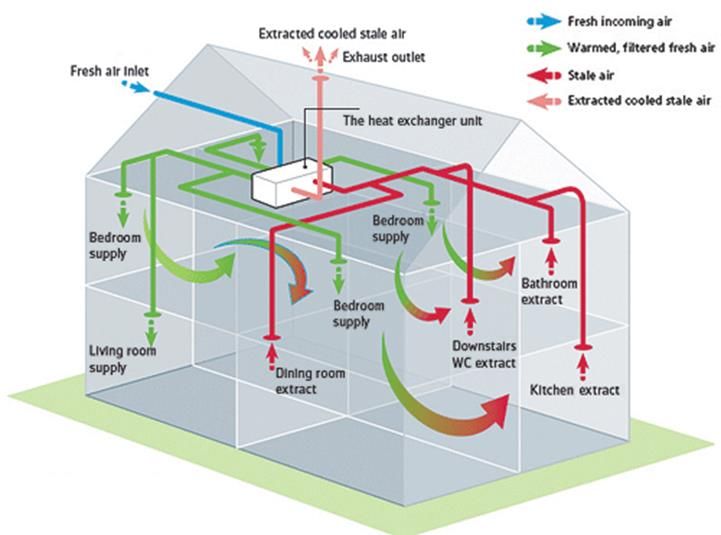
In the quest for energy efficiency and improved indoor air quality, Heat Recovery Ventilation (HRV) has emerged as a groundbreaking solution. This advanced technology addresses the challenge of ventilating homes while retaining heat, making it a key component in modern energy-efficient buildings. Here’s a closer look at the technology driving HRV systems and their benefits.
How Heat Recovery Ventilation Works
Heat Recovery Ventilation systems are designed to optimise the balance between fresh air intake and heat retention. Understanding the core technology behind HRV systems reveals how they achieve this balance.
1. The Role of the Heat Exchanger
The heart of any HRV system is the heat exchanger. This component plays a crucial role in transferring thermal energy between two air streams: the outgoing stale air and the incoming fresh air. Here’s how it works:
- Outgoing Air: As stale air is extracted from the home, it passes through the heat exchanger. This air carries thermal energy that would otherwise be lost.
- Incoming Air: Simultaneously, fresh air from outside enters the system. The heat exchanger transfers the thermal energy from the outgoing air to the incoming air, pre-warming it before it enters the living space.
This process ensures that the home benefits from fresh air without the energy cost associated with heating cold outside air.
2. Achieving Efficient Air Exchange
HRV systems are designed to maintain a balanced airflow (more details). They ensure that the air removed from areas like kitchens and bathrooms is replaced with fresh air in living spaces and bedrooms. This balanced air exchange is crucial for maintaining indoor air quality and preventing issues such as mould growth or excessive humidity.
- Balanced Airflow: The system extracts stale air from high-use areas and introduces fresh air to other parts of the home, ensuring consistent ventilation throughout.
- Humidity Control: By managing air exchange effectively, HRV systems help control indoor humidity levels, reducing the risk of condensation and dampness.
3. Efficiency Metrics
The efficiency of an HRV system is often measured by its Heat Recovery Efficiency (HRE), which indicates the percentage of heat recovered from outgoing air. Most modern systems achieve high efficiency rates, typically between 70% and 90%.
- Heat Recovery Efficiency: This metric reflects how effectively the system transfers heat from the outgoing air to the incoming air. Higher efficiency rates translate to greater energy savings and reduced heating costs.
Advantages of Heat Recovery Ventilation Technology
The technological advancements behind HRV systems offer numerous benefits, particularly for energy conservation and indoor air quality.
1. Energy Savings
By recovering and reusing heat, HRV systems significantly reduce the amount of energy needed to warm incoming air. This leads to substantial savings on heating costs, making HRV systems an economically beneficial choice for homeowners.
- Reduced Heating Costs: With the ability to recover up to 90% of the heat from outgoing air, HRV systems lower the need for additional heating, resulting in lower energy bills.
2. Improved Indoor Air Quality
Continuous ventilation provided by HRV systems ensures that indoor air remains fresh and free of pollutants. This is especially important in tightly sealed homes where indoor air quality can deteriorate due to limited airflow.
- Pollutant Removal: HRV systems help eliminate airborne pollutants, allergens, and excess humidity, contributing to a healthier indoor environment.
3. Consistent Comfort
HRV systems maintain a stable indoor temperature by pre-warming incoming air. This prevents cold drafts and helps maintain a consistent, comfortable environment throughout the home.
- Stable Indoor Climate: By managing the temperature of incoming air, HRV systems enhance overall comfort, particularly during colder months.
Key Considerations for HRV Systems
When selecting an HRV system, several factors should be considered to ensure optimal performance and suitability for your home.
1. System Size and Capacity
Choosing the right size and capacity for an HRV system is essential. Systems that are too small may not provide adequate ventilation, while oversized units may lead to unnecessary energy consumption.
- Proper Sizing: Ensure the HRV system is appropriately sized for the home to achieve efficient air exchange and heat recovery.
2. Installation and Maintenance
Proper installation is crucial for the effective operation of an HRV system. Regular maintenance is also important to ensure continued efficiency and longevity.
- Professional Installation: Engaging a qualified professional for installation can help maximise the system’s performance.
- Routine Maintenance: Regular checks and maintenance are necessary to keep the system running smoothly and efficiently.
The Future of Ventilation Technology
As energy efficiency and indoor air quality continue to gain prominence, the technology behind HRV systems is likely to advance further, according to Steinberg14. Innovations may focus on enhancing efficiency, integrating with smart home systems, and improving ease of installation and maintenance.
For those interested in exploring how heat recovery ventilation can benefit their home, understanding the technology behind HRV systems provides valuable insights into how this technology works and why it’s a worthwhile investment in modern home comfort.





















